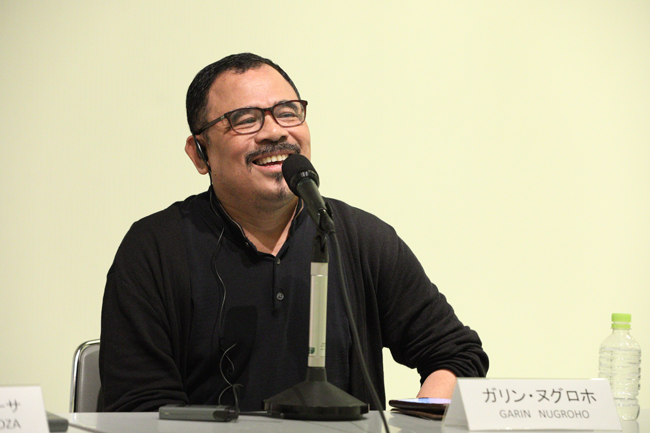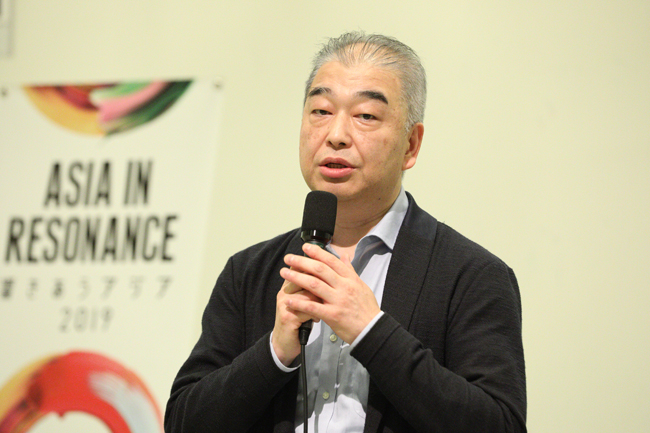The Meaning of Making Films with Other Countries
Ishizaka: So we heard from our three directors about their collaboration in Japan. All three of our guests are directors, but they also are producers, and I think it was very informative to hear from them. Mr. Mendoza talked about the difference in the way of filmmaking between his country and Japan. Mr. Khoo, how about you? Shooting in Japan, did you find any difference from your home country?
Khoo: Like Mr. Mendoza, in Singapore we always shoot very, very fast and sometimes it is spontaneous. So Takumi (Saitoh) who watched the way we were filming, said that it is almost like a documentary. For us, time is always of the essence and normally I don't shoot more than three takes, and if I get it right on the first take, then I will just keep that because I like the sort of spontaneous first shot. In that sense, I was really fortunate to have very good actors in Ramen Teh. And recently I also have been working a lot with Indonesian people in Singapore because I feel that there is a certain dynamic about them and also they work very fast. I am one of the most impatient people, so I have to go chop, chop, chop, and see who does that best, it is great when you have a production with people from all over Asia coming together.
Ishizaka: Since we have Ms. Mutsuko Shio, a representative of the Takasaki Film Commission who collaborated with the team for Ramen Teh from Singapore, I would like to ask her. As the Japanese counterpart, is there anything you were careful about?
Shio: This was actually the first time for us to work with a non-Japanese crew, so it was an adventure and it was also something that we looked forward to. Working with them, I found everyone from Singapore including Eric very flexible, and compared to the Japanese crew, the pace of work is different. So it was very educational for us, because they opened our eyes to new ways of doing things. And in the process of filmmaking, there was a language barrier because none of my teammates could speak English well, but when it comes to filmmaking, once you form a bond, we realized that we could work together to create a story and that was really enjoyable. And with that relationship established, we were able to welcome Eric back again as a producer for another project, and we are hoping that we can expand this connection with people from other countries.
Ishizaka: Like Takasaki city, I think that there are lot of film commissions in local areas around Japan and I think these opportunities will increase hereafter. By the way, a while ago Mr. Khoo was talking about how wonderful his Indonesian staff is. From your perspective, Mr. Nugroho, as an Indonesian, what do you think about it?
Nugroho: It is difficult to answer. I think it is because there are so many paradoxes in Indonesia and it is a chaotic country in some perspectives. Maybe people in the Philippines are similar, but there is so much creativity in the chaotic atmosphere where every single artist must survive through adaptation. With adaptation they should be able to absorb everything. It means you must develop your craft, your way, and your strategy at a fast pace.
Filmmaking is like a traditional ceremony in which everybody comes together with a different specialty and creates something through their collaboration. Everything in the process is a collaboration, so it is a kind of "Happening Art." And I think this method of spontaneity can develop more strongly if every single artist who participates has a strong character, strong craft and science background, and knows the art of storytelling very well. Happening Art is like a clown in the circus, and I think it is a good example for what is the beauty of spontaneity. And I think that in Asia, when every single artist is given room for spontaneity, we get the feeling of being taken not only to our history but also to contemporary art. And now in this digital era, we don't have any borders. We can discuss with anybody at any time with some application, and that gives new meaning and new perspectives to Happening art, participation, or even distribution and dialogue. Moreover, with Virtual Reality, I think it will be more interesting. There is always a question of how we could make the script and Happening Art in Virtual Reality in the future. But I believe that we can develop new creativity, a new collaboration among Asian artists, since Asia has so many different cultures and so many paradoxes between chaos and beauty, between rich and poor.

Ishizaka: That is very interesting. So as we have been talking about filming in Japan or film collaboration with Japan, I would like to ask three of you your hopes and expectations for its future development. If you are to film in Japan in the future, on what kind of theme would you like to film?
Khoo: I am now thinking about a story of a Japanese ghost, and it will be a bit of a musical. I am also very fascinated by snow, like Mr. Mendoza, because Singapore is so hot with a lot of mosquitoes. Recently I saw a fantastic movie by Mikio Naruse called Scattered Clouds (1967) at the Vesoul Film Festival, which gave me some inspiration, too.
Mendoza: My next project is about a Japanese boxer and a Filipino boxer, and this time again we would like to portray the connection of Japan and the Philippines between these two characters.
Nugroho: Last week I just finished a collaboration in making a musical produced in Indonesia with costume from Thailand and the cast mostly from Singapore. This was a very well-developed collaboration among Asians. We must make a special note that in these years many directors have become producers in Asia, and it is a very interesting story in the Asian film history, because the majority of producers were European before. We must support and try to develop that kind of new perspective, that more and more producers develop film or Expanded Cinema that can develop so many sources like stories, actors, music, and also dance in Asia.
Ishizaka: When you think about Japanese directors who work with counterparts in Southeast Asia, there are more and more projects happening now. Like Takumi Saitoh, Koji Fukada (The Man of the Sea) and Kuzoku of Bangkok Nites (2016) and so on. Also there are many omnibus film projects where several directors collaborate together. There must be a certain significance in these multi-national co-productions, such as expanding the market to other countries, but aside from that, is there anything artistically valuable in working with people from other countries or making films in a foreign land? What do you think of its meaning?

Khoo: Like in Thailand, when they do a film shoot, they actually cook food on location and that is really unique and the food is delicious. So I think we do things in very peculiar ways, strange ways, but it is also exciting when you can bring it all together.
Mendoza: Basically it is observing. You learn when you work with different crews from other countries, specifically in my case with a Japanese crew. They are known for being very precise in terms of timing, while Filipinos are known for not being on time, so you have to adjust and in doing so, it becomes productive. This is only one of the instances where you learn from other cultures and other people. In terms of creative aspects, I didn't feel much difference between Japanese actors and Filipino actors by directing them. They just love to collaborate and to listen to others. So as far as trying to deliver your creativity or trying to make a creative atmosphere on the set, you realize nationality does not matter. It is more of listening, adopting, and learning from one another.
Nugroho: Last day, when Yasu and I had a discussion on the project, I told him "Each day is different, so don't worry. Every day is always full of suspense and surprise." The essence of drama is suspense and surprise, and without them there is no drama. The wonderful thing about collaboration is that there is always suspense and surprise. I love those very much so I never worry about collaboration. But at the same time, worry is a source of chaos, and chaos is a source of creativity, too.
But now, with the new dimension of the cinema, where we can see films anywhere, like on Netflix, where the contents are required to have some local elements. For example, if there is a film played by Indonesian actors and produced by Singaporeans or the Filipinos, it needs several cultural elements, since it will be brought to several countries. So like films for HBO Asia or blockbusters films, they are targeting Indonesia, since it is a big market with a population of 250 million, and furthermore actors from India or China are playing because their market is very big as well. So in the near future, films are not presented by one nationality, but by many nationalities. And this opportunity can be used by independent films, too. With the new perspective of distribution, actors and actresses can develop the market and gain the attention of new audiences. So all directors and producers must cross the border to find opportunities for collaboration with other countries. In this digital era where there is no border for films, this is the new era of multi-cultural opportunities. I think that collaboration in filmmaking in Asia will be more interesting in different perspectives with new technology because our friends in Asia work as guerillas--even though their industry is small, they have talents and creativity and can push through and transcend all borders in this area.






